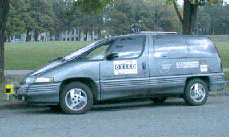
Vehicle tracking is an important application of computer vision. In an automated driving system, both numerical or quantitative tracking and symbolic or qualitative tracking are the prerequisites for the success of other autonomous driving tasks such as motion planning, obstacle detection, and path planning. Accurate motion estimation allows safe and efficient motion planning, while symbolic motion interpretation simplifies the reasoning procedure by presenting useful information in an efficient manner. So it becomes attractive to integrate quantitative and qualitative motion analysis in a single tracking system, enabling an automated car to react quickly and correctly to the rapid maneuvers of other vehicles.
In this project, we developed a real-time vehicle tracking system which provides quantitative and qualitative motion estimates simultaneously from a moving platform and using a laser range-finder. The system was developed in the context of the Automated Highway System project and is intended to provide accurate motion estimation, motion classification, and reliable maneuver detection. First, we construct three motion models (constant velocity, constant acceleration, and turning) to describe the qualitative motion of a moving car. Then the models are incorporated into the Extended Kalman Filters to perform quantitative tracking. Finally, we develop an Extended Interacting Multiple Model (EIMM) algorithm to manage the switching between models and to output both qualitative and quantitative motion estimates of the tracked car. Accurate motion modeling and efficient model management result in a high performance tracking system.
The experiments were conducted using Navlab5:

Here is a movie demonstrating car tracking from a sequence of range images:

L. Zhao, C. Thorpe, "Qualitative and Quantitative Car Tracking from a Range Image Sequence", Proc. 1998 Computer Society Conference on Computer Vision and Pattern Recognition (CVPR'98), Santa Barbara, pp. 496-501, June 23-25, 1998.